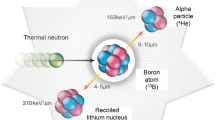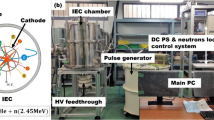Abstract
The methods of proton targeted therapy have been proposed in many researches as the technique to enhance the biological effectiveness of proton therapy. In this regard, different materials, such as high-Z targets or boron and, recently, carbon nanoparticles, have been tested theoretically and experimentally. The present work as the continuation of our previous study has been performed to assess the method of using the carbon nanoparticles in proton therapy. The carbon nanoparticles inclusion not only increased the dose related to the high Linear Energy Transfer (LET) secondary alpha particles (100% increase) but also, led to two phenomena with greater impacts; the recoil carbon ions into the cancerous tissue and the slowed-down primary protons when passing through the target. The calculations showed 300% increase in dose related to the recoil carbon ions. Also, an enhancement in total proton effectiveness was observed from the small fraction of the primary protons which have been slowed down by the target atoms and fallen into the higher-LET region. Hence, the dose related to the low energy protons enhanced up to several orders of magnitude and a considerable increased in total proton dose as well. The present study has been performed in a micro-scale and using GEANT4 for dose evaluation and GEANT4-DNA as the extension of GEANT4 code for studying the induced DNA damages from mentioned charged particles. The novelty of this work is the demonstration of the potential for enhancing the Relative Biological Effectiveness in conventional proton therapy significantly.





Similar content being viewed by others
Data Availability Statement
This manuscript has associated data in a data repository. [Authors’ comment: The datasets generated and/or analyzed during the current study are available from the corresponding author.]
References
H. Paganetti, Relative biological effectiveness (RBE) values for proton beam therapy. Variations as a function of biological endpoint, dose, and linear energy transfer. Phys. Med. Biol. 59, 419–472 (2014). https://doi.org/10.1088/0031-9155/59/22/R419
H. Suit et al., Proton vs carbon ion beams in the definitive radiation treatment of cancer patients. Radiother. Oncol. 95, 2–22 (2010). https://doi.org/10.1016/j.radonc.2010.01.015
S. Rajabpour, H. Saberi, J. Rasouli, N. Jabbari, Comparing Geant4 physics models for proton-induced dose deposition and radiolysis enhancement from a gold nanoparticle. NATURE Sci. Rep. 12, 1779 (2020). https://doi.org/10.1038/s41598-022-05748-0
N.H. Huynh, J.C.L. Chow, DNA dosimetry with gold nanoparticle irradiated by proton beam: a Monte Carlo Study on dose enhancement. Appl. Sci. 11, 10856 (2021). https://doi.org/10.3390/app112210856
S.J. Hosseini et al., DSB and SSB damages by 0.1–20MeV protons enhanced by high-Z nanoparticles computed using Geant4-DNA. J. Instrum. (2022). https://doi.org/10.1088/1748-0221/17/05/P05034
D.K. Yoon, J.Y. Jung, T.S. Suh, Application of proton boron fusion reaction to radiation therapy, A Monte Carlo simulation study. Appl. Phys. Lett. 105, 223507 (2014)
F. Tabbakh et al., Using 157Gd doped carbon and 157GdF4 nanoparticles in proton-targeted therapy for effectiveness enhancement and thermal neutron reduction: a simulation study. Nat. Sci. Rep. 12, 17404 (2022). https://doi.org/10.1038/s41598-022-22429-0
A.E. Schwint, V.A. Trivillin, ’Close-to-ideal’ tumor boron targeting for boron neutron capture therapy is possible with ‘less-than ideal’ boron carriers. Ther. Deliv. 6, 269–272 (2015)
M. Hosobuchi et al., Experimental verification of efficacy of pBCT in terms of physical and biological aspects. Nucl. Instrum. Methods Phys. Res. Sect. A (2023). https://doi.org/10.1016/j.nima.2022.167537
S. Kim et al., Analysis of therapeutic effectiveness attained through generation of three alpha particles in proton-boron reaction based on the Monte Carlo simulation Code. J. Radioanal. Nucl. Chem. (2018). https://doi.org/10.1007/s10967-018-5813-5
Z. Ahmadi Ganjeh, M. Eslami-Kalantari, Investigation of proton-boron capture therapy vs. proton therapy. Nucl. Instrum. Methods Phys. Res. A (2020). https://doi.org/10.1016/j.nima.2020.164340
A. Mazzone, P. Finocciaro, Lo. Meo, N. Colonna, On the (un) effectiveness of proton boron capture in proton therapy. Eur. Phys. J. Plus 134, 361 (2019). https://doi.org/10.1140/epjp/i2019-12725-8
N. Khaledi, X. Wang, R.B. Hosseinabadi, F. Samiei, Is the proton–boron fusion therapy effective? J. Radiother. Pract. (2020). https://doi.org/10.1017/S1460396920000151
M. Mastromarco et al., Proton boron capture therapy: dose calculation and possible new measurement. RAD Conf. Proc. 4, 1–4 (2020). https://doi.org/10.21175/RadProc.2020.00
G.W. Barendsen, The relationships between RBE and LET for different types of lethal damage in mammalian cells: biophysical and molecular mechanisms. Radiat. Res. 139, 257–270 (1994)
H. Paganetti, Significance and implementation of RBE variations in proton beam therapy. Technol. Cancer Res. Treat. 2(5), 413–426 (2003)
C. Villagrasa et al., RBE–LET relationship for proton andalpha irradiations studied with a nanodosimetric approach. Radiat. Prot. Dosim. (2014). https://doi.org/10.1093/rpd/ncu047
S. Agostinelli et al., GEANT4-a simulation toolkit. Nucl. Instrum. Methods Sect. A 506(3), 250–303 (2003)
J. Allison et al., GEANT4 development and applications. IEEE Trans. Nucl. Sci. 53(1), 270–278 (2006)
P. Cirrone et al., Hadrontherapy: a Geant4-based tool for proton/ion-therapy studies. Prog. Nucl. Sci. Technol. 2, 207–212 (2011)
M.A. Bernal et al., Phys. Med. 31, 861–874 (2015). https://doi.org/10.1016/j.ejmp.2015.10.087
S. Incerti et al., Med. Phys. 37, 4692–4708 (2010). https://doi.org/10.1118/1.3476457
S. Incerti et al., The Geant4-DNA project. Int. J. Model. Simul. Sci. Comput. 1(2), 157–178 (2010). https://doi.org/10.1142/S1793962310000122
N. Tang et al., Influence of chromatin compaction on simulated early radiation-induced DNA damage using Geant4-DNA. Med. Phys. (2019). https://doi.org/10.1002/mp.13405
F. Kalholm, L. Grzanka, E. Traneus, N. Bassler, A systemtic review on the usage of averaged LET in radiation biology for particle therapy. Radiother. Oncol. 161, 211–221 (2021). https://doi.org/10.1016/j.radonc.2021.04.007
M. Belli et al., Inactivation and mutation induction in V79 cells by low energy protons: reevaluation of the results at the LNL facility. Int. J. Radiat. Biol. 63, 331–337 (1993)
R. Roots, W. Holley, A. Chatterjee, E. Rachal, G. Kraft, The influence of radiation quality on the formation of DNA breaks. Adv. Space Res. 9, 45–55 (1989)
G. Taucher-Scholz, J. Heilmann, M. Schneider, G. Kraft, Detection of heavy-ioninduced DNA double-strand breaks using static-field gel electrophoresis. Radiat. Environ. Biophys. 34, 101–106 (1995)
G. Taucher-Scholz, J. Heilmann, G. Kraft, Induction and rejoining of DNA double-strand breaks in CHO cells after heavy ion irradiation. Adv. Space Res. 18, 83–92 (1996)
ICRU. Stopping of ions heavier than helium. ICRU Report 73 (Oxford University Press, Oxford, 2005)
ICRU, Stopping Powers and Ranges for Protons and Alpha Particles, ICRU Report 49, (Bethesda, 1993)
S. Incerti et al., Geant4-DNA example applications for track structure simulations in liquid water: a report from the Geant4-DNA Project. Med. Phys. 45(8), 722–739 (2018). https://doi.org/10.1002/mp.13048
D.T. Goodhead et al., Direct comparison between protons and alpha-particles of the same LET: I. Irradiation methods and inactivation of asynchronous V79, HeLa and 10T1/2 cells. Int. J. Radiat. Biol. 61, 611–624 (1992)
Y. Furusawa et al., Inactivation of aerobic and hypoxic cells from three different cell lines by accelerated 3He-, 12C- and 20Ne-ion beams. Radiat. Res. 154, 484–496 (2000)
C. Grassberger, H. Paganetti, Elevated LET components in clinical proton beams. Phys. Med. Biol. 56, 6677–6691 (2011). https://doi.org/10.1088/0031-9155/56/20/011
M. Folkard et al., Inactivation of V79 cells by low-energy protons, deuterons and helium-3 ions. Int. J. Radiat. Biol. 69(6), 729–738 (1996)
J.J. Wilkens, U. Oelfke, Direct comparison of biologically optimized spread-out Bragg peaks for protons and carbon ions. Int. J. Radiat. Oncol. Biol. Phys. 70(1), 262–266 (2008)
T. Wenzl, J.J. Wilkens, Theoretical analysis of the dose dependence of the oxygen enhancement ratio and its relevance for clinical applications. Radiat. Oncol. 6, 171 (2011)
F. Guan et al., Analysis of the track- and dose-averaged LET and LET spectra in proton therapy using the geant4 Monte Carlo code. Med. Phys. 42(11), 6234–6247 (2015)
F. Tabbakh, N.S. Hosmane, Enhancement of radiation effectiveness in proton therapy; comparison between fusion and fission and further approaches. Nat. Sci. Rep. 10, 5466 (2020). https://doi.org/10.1038/s41598-020-62268-5
Acknowledgements
The authors would like to acknowledge the Plasma and Nuclear Fusion Research School, Nuclear Science and Technology Research Institute and the Department of Chemistry and Biochemistry, Northern Illinois University for supporting this work.
Funding
No funding was received for conducting this study.
Author information
Authors and Affiliations
Contributions
Dr. FT conducted the experiment(s), Dr. FT and Prof. Dr. NSH formed the discussions. All authors reviewed the manuscript.
Corresponding author
Ethics declarations
Conflict of interest
The authors of the present work declare no competing financial interests.
Human and animal rights
In the present study, no human (or animal) tissue was involved.
Rights and permissions
Springer Nature or its licensor (e.g. a society or other partner) holds exclusive rights to this article under a publishing agreement with the author(s) or other rightsholder(s); author self-archiving of the accepted manuscript version of this article is solely governed by the terms of such publishing agreement and applicable law.
About this article
Cite this article
Tabbakh, F., Hosmane, N.S. Enhanced biological effectiveness with carbon nanoparticles in proton therapy: a simulation study. Eur. Phys. J. Plus 138, 538 (2023). https://doi.org/10.1140/epjp/s13360-023-04150-7
Received:
Accepted:
Published:
DOI: https://doi.org/10.1140/epjp/s13360-023-04150-7




